Food Tour of Iowa: Ebert Honey
The first time I e-mailed Phil Ebert about visiting his honey farm, the answer I received told me it would be a memorable experience. To quote:
I've got about 50 colonies of bees within flying distance of our
building. They have been trying to invade. It's a little daunting if
you have never been around bees.
It should be mentioned that I have, in fact, never “been around bees”. I was happy enough to wait until the cold weather and termination of whatever processes were causing the bees to invade to quiet down. Fortunately, they had done so by this past Thursday and I was able to visit.
Phil Ebert lives in the small Iowa farm town of Lynnville. He greeted me very kindly as I pulled into the driveway, and right away gave me a quick but thorough overview of the honey extraction process, which was carried out in the building which the bees were trying to invade earlier.
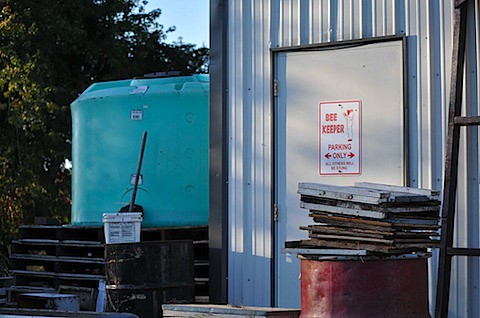
Above: The honey extraction shed
In fact, to my city based sensibilities, they still were trying to invade the simple aluminum building which housed all of Phil’s honey processing equipment. With the carefree advice of “Don’t mind the bees; they won’t hurt you. At worst, they’ll just bump into you”, he ushered me into the processing shed.
The first room was filled with 55 gallon barrels, as well as more bees than I cared to count. Phil, however, only commented on the barrels, which all contained honey. As I learned from Phil, bees will come after the harvested frames until they have been put into barrels- his task last week was to extract the honey from the frames into barrels so that the bees would stop swarming, and that mites would not eat the honey.
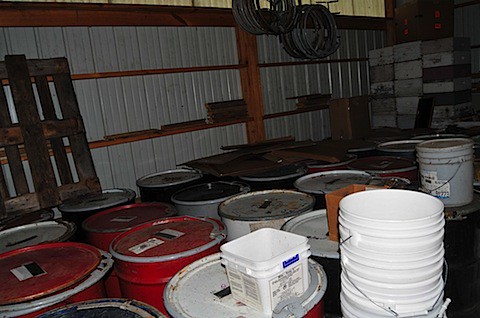
Above: Barrels of extracted honey, waiting to be bottled
Frames are the building block of the bee “colonies”, which I would call hives. Each hive consists of two boxes stacked on top of each other, both of which are filled with frames. The bees build their honeycomb on the frames which are the building block of the honey extraction process.
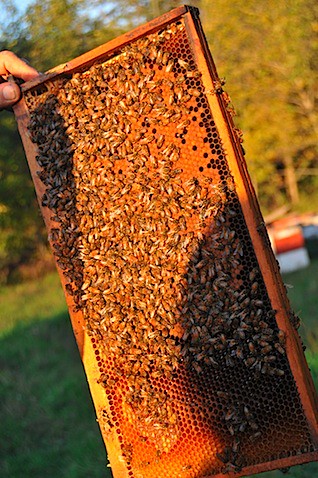
Above: In the field, Phil shows me a frame fresh out of one of his colonies
For Phil to get to the honey, he first removes the frames. This is a tricky operation for two reasons: bees get angry and honey is heavy. A smoke blower attached to a truck solves the first obstacle. The smoke calms down the bees, and the frames are then removed from the colonies and put into the truck. For the second, there is not such an easy solution; just smaller boxes for the frames. Honey weighs about 12 pounds a gallon, about 1.5 times heavier than water. This means a regular sized box (the type one sees on a normal commercial beekeeping facility) weighs 90 pounds. Phil uses a mix; normal sized boxes to breed the queens and drones (more on that later) and a smaller type to collect honey. The smaller only weighs 45 pounds when filled with honey.
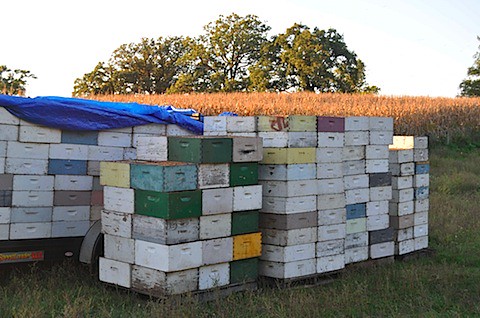
Above: Boxes stacked after having their frames removed. Each one of these weighs about 45 pounds when filled with honey.
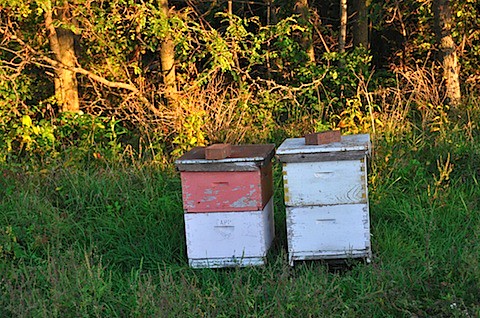
Above: Two colonies
After the frames have been collected and safely stashed in the extraction shed, the tops of the honeycombs are “uncapped” by a machine specially made for the job. This machine slices off the top of the honeycomb so that the honey can flow unrestricted out.
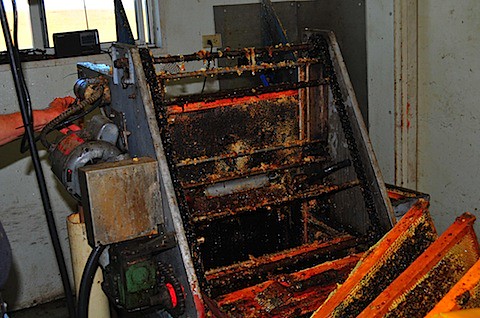
Above: The "uncapper"
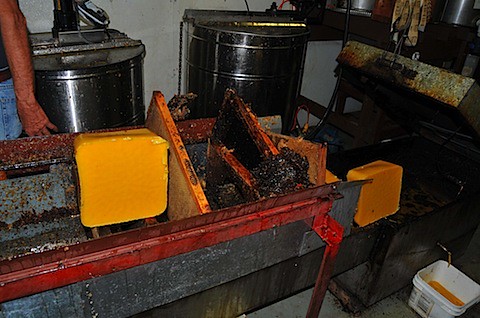
Above: The wax extracting part of the uncapper. The metal drums in the background are the extractors, which spin the uncapped frames to remove the honey. The big yellow blocks are wax.
After uncapping, Phil loads the frames into an big metal cylinder called an extractor, which spins the frames to separate the honey from the wax. This mixture is then pumped through yet another machine called a refiner. The refiner pumps the honey through a series of filters to purify the honey, and then into a 55-gallon barrel for storage. When the stored honey is ready to be bottled, Phil warms the barrel and bottles the honey for distribution to grocery stores and farmers markets across Iowa, so that Iowans may add delicious honey to their biscuits and pork chops!
In addition to honey, this process also produces wax. Phil previously used this to make his own candles; now he sells it in bulk on the Internet, to be purchased by furniture and candle makers and such. He has also had such diverse buyers as a monastery (more candles) and a antique radio refurbisher. Interestingly, he generally does not have enough wax to keep pace with demand.
After viewing the refinery, Phil took me out to see the nearest set of colonies, where his son, Alex, breeds queens. At this point, it might be helpful to elaborate on just what beekeeping actually entails- there’s more to it than you might think.
Contrary to my belief, honey sales are not the only way for beekeepers to make money. There are actually 3 ways beekeepers make money: selling bees, selling honey (and wax) and providing pollination services.
Bee selling is the process of breeding queen bees (there needs to be one in each hive) and drone bees (the workers) and selling these bees to other beekeepers that have lost queens or workers and need to repopulate colonies. This has become increasingly important as the health of bees has become more and more fragile in response to changes in the environment. When Phil started in 1980, he would ask how many seasons a queen would last. Today, beekeepers hope more and more that a queen bee will last the season.
Honey, as discussed, is the process of removing the honey from the hives. The wax generated is also a potential revenue sources, although not a primary one for Phil.
The real money, Phil told me, comes from pollination services. In his case, this means he has colonies 75 miles away at orchards and other such places to ensure that the buds are pollinated and will come to fruit. For beekeepers, this is essentially free money; they just need to park the colonies and leave them alone, visiting occasionally to make sure that they don’t die.
The way Phil generates runs his business is radically different than the way the larger operations run theirs. The first difference is that Phil is mainly in it to make honey. He breeds some queens and drones for personal use (although he still must supplement by buying queens and drones-especially early in the season) and provides some pollination services to local orchards, but honey is his main revenue source. Commercial beekeepers mainly generate their revenue by carting their bees around in semi’s, motoring up states like California, pollinating orange and almond orchards. Commercial beekeepers that do that rarely produce honey anymore; preferring instead to focus solely on pollination services.
The second difference is scale. Phil, with only about 500 colonies, is a maverick in an industry where 1,000 colonies are widely considered to be the minimum amount needed to be commercially viable. The largest beekeepers have anywhere from 35 to 80 thousand colonies- a different scale altogether.
As such a small producer, Phil is exposed to unique pressures. He faces difficulties with the variability of the bees as well as the market for honey. He is entirely dependent upon the health of his colonies and the honey they are producing. For this reason, he is more sensitive than most to the pressures on bees and their honey making capacity that have emerged in the last 28 years.
On the most basic level is a decline in the robustness of the colonies. When he started, a bad winter might kill 5-10% of the colonies under his control. Now, 50% is not an uncommon death rate. This means he needs to buy more expensive drone and queen bees early in the season to keep up with honey production. He blames the increased use of sparingly tested pesticides, as well as the increased homogenization of agriculture on the sickliness of his bees. Corn and soybeans now come inoculated with pesticides to decrease the amount lost to pests; however, the effects of these pesticides on bees are rarely understood. In addition, the homogenization of pollen producing plants limits the health of the bees, which rely on a varied diet of high protein pollen to stay healthy. If the crop of the season is one that mostly has low protein pollen, the bees healthy drops.
This reliance of the whimsical health of bees, as well as the weather and the harshness of the winters, means Phil has a lot of volatility to contend with. In his best year to date, 2004, he filled 138 55 gallon barrels of honey; a bumper crop. A few years before, he filled less than 50.
Phil is operating in a world that doesn’t exist anymore. In 1950, there were 200,000 colonies of bees in Iowa. Today, there are only 30,000, and almost all of those are in the hands of a few commercial beekeepers.
No comments:
Post a Comment